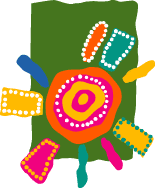
|

For most of the twentieth century assimilation policies erased the evidence for the diversity of Aboriginal art.
The well-established ethnographic stereotype for an authentic and traditional Aboriginality was associated with the 'real' Aborigines in northern Australia.
The assumption was made that Aborigines in 'settled' Australia, had no traditions and, as a result, their art was seen to be inauthentic.
Aboriginal people in 'settled' Australia were rendered invisible. (See also module 1: Colonial realities.) In reality Aborigines in the southern 'settled' states have a dynamic and distinctive culture displaying continuims with the past, diversity and difference.
|
|

Key concepts |
• Koori
• the politics of invisibility
|
|
|
 |
Read pp. 319-368 |
|
Settler Australia
The colonial experiences of Aboriginal people in 'settled' Australia were very different from those of Aboriginal people to the centre and north of Australia. Morphy writes, in 'settled' Australia where colonisation first occurred, Aboriginal people "almost lost contact with the Dreaming for more than a century"(p. 319). As victims of colonisation Aborigines were dispossessed of their land, decimated by disease and violence, their children forcibly removed, and their culture all but destroyed.
By the end of the nineteenth century it was assumed that Aboriginal culture in 'settled' Australia was destroyed: Aboriginal people had no "presence in the land" (Morphy p. 319). Nevertheless several artists had emerged to prominence: William Barak, Tommy McRae and Mickey of Ulladulla. |
|
|
| |
Why were Kooris invisible? |
|
Aboriginal invisibility
Aborigines were rendered invisible in three ways:
- oppressive and discriminatory government polices of assimilation.
- Aboriginality was associated with the distant past or remote communities to the centre and north of the continent.
- 'primitive art' excluded recognition for Aboriginal art in 'settled' Australia.
|
|
|
| |
What is the importance of the name Koori? |
|
Koori
Names count. In the 1960s and 1970s Aborigines in Victoria and New South Wales Australia adopted the collective term Koori as an assertion of independence and unity. Koori had long been used by Aboriginal communities before it became public.
Nowadays many Aborigines prefer to be called by their own name:
- Nunga in South Australia;
- Nyungah or Nyungarr in Western Australia; and
- Murri in northern New South Wales and Queensland.
|
|
|

|
Neale: United in the struggle...
In the 1960s and 1970s the city became a catalyst for cultural renewal. Indigenous curator Margo Neale writes that "The exhibition 'Koori Art 84' at Artspace in Surry Hills, Sydney, opened a new chapter in Australian art history." For the first time, artists who had previously worked in isolation, exhibited together united in a spirit of cultural pride and political protest.
|
|
|

|
Onus: Southwest, Southeast ...
Indigenous artist Lin Onus writes a history of Aboriginal art in south eastern Australia from a Koori perspective. Although a great deal of cultural knowledge was lost, cultural traditions continued to be maintained through the work of 19th century artists such as William Barak (Illustrations 237-9), and Tommy McRae (Illustrations 240-2) the production of artefacts for the tourist industry and the work of artists like Albert Namatjira, Dick Roughsey (Illustration 236), Ronald Bull and Revel Cooper (Illustration 245) who worked in a European landscape style.
| |
|
| |
|
|
|
 |
Key themes
Look at the following illustrations in Morphy to see the diversity of Aboriginal and Torres Strait Islander art and key themes.
- Ellen Jose RIP Tera Nullius, 26 June 1992 (Illustration 227).
- Ken Thaiday Whoumerr frigate bird dance mask, 1991 (Illustration 225).
- Thancoupie, Corrup the Kangaroo and Chinjari the Wallaby, 1994 (Illustration 235)
- Fiona Foley, The Annihilation of Blacks, 1986 (Illustration 260).
- Judy Watson, the guardians, guardian spirit, 1986-7 (Illustration 263).
- Gordon Bennett, Outsider, 1988 (Illustration 268).
- Robert Campbell Junior, Striking for Pay, Wattie Creek, 1990.
- Lin Onus, Portrait of Jack Wunuwun, 1988 (Illustration 256).
- Julie Gough, The Trouble with Rolf, 1996, (Illustration 272)
- Trevor Nickolls, Dreamtime Machinetime, 1981 (Illustration 254).
- Ian Abdullah From The River Series, 1990 (Illustration 267).
- Sally Morgan, Citizenship, 1987 (Illustration 251).
Share your ideas about these artworks and their themes on the Learnline Discussion Board. |
|
|
| |
 |
 |
|
|
|